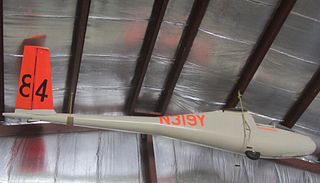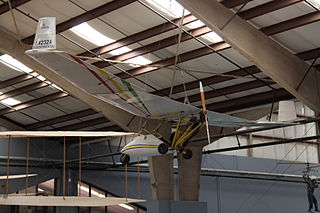
The Rutan Model 76 Voyager was the first aircraft to fly around the world without stopping or refueling. It was piloted by Dick Rutan and Jeana Yeager. The flight took off from Edwards Air Force Base's 15,000 foot runway in the Mojave Desert on December 14, 1986, and ended 9 days, 3 minutes and 44 seconds later on December 23, setting a flight endurance record. The aircraft flew westbound 26,366 statute miles at an average altitude of 11,000 feet (3,350 m).
The Advanced Soaring Concepts Falcon, also called the Advanced Soaring Concepts American Falcon, is an American mid-wing, T-tailed, single-seat, FAI 15-Metre Class glider that was designed by Tor Jensen and produced by Advanced Soaring Concepts, and first flew in 1993. The aircraft was produced as a kit for amateur construction.

The Rutan Quickie is a lightweight single-seat taildragger aircraft of composite construction, configured with tandem wings.

The Cozy Mark IV is a 4-seat, single engine, homebuilt light aircraft designed by Nat Puffer, with parts and plans supplied by Aircraft Spruce & Specialty Co. The aircraft is built from plans using basic raw materials. It is not a kit aircraft, though many small parts are available prefabricated. The Cozy is similar in design and construction to the 2-seat Rutan Long-EZ, from which it is derived, with approval from Burt Rutan.

The Berkut 360 is a tandem-seating, two-seat homebuilt canard aircraft with pusher configuration and retractable landing gear, built primarily of carbon fiber and fiberglass.

The Cozy III is a 3-seat, single engine, homebuilt light aircraft designed by Nat Puffer. The aircraft is built from plans using basic raw materials. It is not a kit aircraft, though many small parts are available prefabricated. The Cozy is similar in design and construction to the 2-seat Rutan Long-EZ, from which it is derived, with approval from Burt Rutan.

The Pterodactyl Ascender is a family of U.S. designed and built ultralight aircraft that were sold in kit form between 1979 and 1984 under Pterodactyl Limited and is currently being sold by DFE Ultralights.

The HP-18 is a Richard Schreder-designed metal Racing Class sailplane that was offered as a kit for homebuilding during the 1970s and 1980s.

The IS-5 Kaczka was a single-seat canard research glider designed and built in Poland from 1948.

The Bowlus/Nelson BB-1 Dragonfly is an American, two seat, strut-braced, high-wing motor glider that was developed from the Bowlus BA-100 Baby Albatross glider by Hawley Bowlus.
The Applebay Zia is an American, single-seat, high-wing, twin-boom, pusher configuration motor glider that was designed by George Applebay for the 1982 Sailplane Homebuilders Association Homebuilt Sailplane Design Contest. The aircraft was intended to be offered as a factory completed aircraft or as a kit. It first flew in 1982.

The Haig Minibat is a high-wing, single-seat tailless motor glider that was designed by Larry Haig, and first flown in 1979. At one time available as plans or in kit form for amateur construction. The kit is no longer available.

The Laister LP-15 Nugget is an American single-seat, high-wing glider designed by Jack and Bill Laister for the FAI Standard Class. It first flew in 1971.

The Schreder Airmate HP-10 is an American, high wing, single seat, FAI Standard Class glider that was designed by Richard Schreder. Airmate was the name of Schreder's design company.

The Johnson RHJ-6 Adastra was an American mid-wing, two-seat glider that was designed and constructed by Dick Johnson and first flown on 3 April 1960.
The Maupin Windrose is an American high-wing, single-seat glider and motor glider that was designed by Jim Maupin for the Sailplane Homebuilders Association Design Contest.

The Radab Windex is a family of Swedish high-wing, single-seat aerobatic gliders and motor gliders that was designed by Sven Olof Ridder and produced initially by Radab and later by WindexAir AB as a kit for amateur construction.
The Goldwing Ltd Goldwing is an American ultralight aircraft that was designed by Craig Catto and Brian Glenn and produced by Goldwing Ltd. The aircraft was supplied as a complete factory-built aircraft only and no kits or plans were offered.

The Mitchell Wing B-10 is an American high-wing, open cockpit, single-seat, tailless, ultralight aircraft and motor glider designed by Don Mitchell and based on his Mitchell Wing hang-glider. It has been produced by a variety of companies in the form of kits and plans for amateur construction. It first flew in 1980.

The Quickie Q2 or Q2 is a two-seat version of the unique Rutan Quickie, produced in kit form by the Quickie Aircraft Corporation founded by Tom Jewett and Gene Sheehan. Canadian Garry LeGare was involved in the design.
















